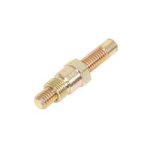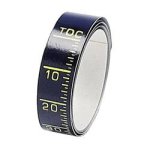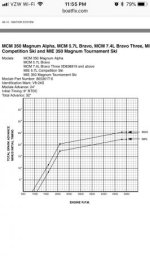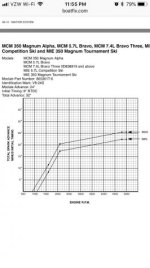Remanufactured 5.7 EFI (not MPI) in my 98 Chapparal Sunesta 232 w/ a bravo 3 outdrive. Delco EST ignition.
Before i learned to properly set base timing at 8 deg I set timing by listening to the motor. It would run 44mph on GPS with just me and a full tank of gas with 24* props at about 4400rpm.
Starter installed by a shop was the wrong one so it eventually chipped off flywheel teeth. New flywheel and starter later I get the boat back and timing needed to be set. I set it to 8 deg BTDC w a digital advance light. Now the motor won’t rev as high as it did and won’t hit the same speed. I’m down to 39mph and motor won’t rev over 4200rpm. Changing props to 22* I pick up 200rpm but lose speed. Motor sounds good but just stops pulling as the RPMs cross 4000ish
so my question: given the Delco EST ignition curve, if I know I’m not going to rev to max RPM of this motor (either with 24* or possibly the stock 26* props), can I add a degree or 2 of timing without hurting anything?
In my quest to find the lost power, I have changed plugs, wires, cap, rotor, and even swapped out the distributor just to see if I had an gremlins in the old one. So far it hasn’t helped. I did find a missing ground strap from when the shop had the motor apart so that fixed a high-end miss I was getting (and the motor leaning out). But even still, I’m down power on a motor that has less than 20 hours on it. Oh, compression check showed all was well (all cylinders within 5% of each other).
Ideas? Figured I’d ask before trial-and-error time...
Some other random info: fuel filter was changed. Fuel has been fine. Fuel pressure is verified stable at 30psi throughout the RPM range (and WOT) as specified in the manual. I know timing is advancing (verified w light while under load). IAC, MAP, and TPS all replaced as part of my exercise. Ignition coil as well. No change in performance.
JD
Before i learned to properly set base timing at 8 deg I set timing by listening to the motor. It would run 44mph on GPS with just me and a full tank of gas with 24* props at about 4400rpm.
Starter installed by a shop was the wrong one so it eventually chipped off flywheel teeth. New flywheel and starter later I get the boat back and timing needed to be set. I set it to 8 deg BTDC w a digital advance light. Now the motor won’t rev as high as it did and won’t hit the same speed. I’m down to 39mph and motor won’t rev over 4200rpm. Changing props to 22* I pick up 200rpm but lose speed. Motor sounds good but just stops pulling as the RPMs cross 4000ish
so my question: given the Delco EST ignition curve, if I know I’m not going to rev to max RPM of this motor (either with 24* or possibly the stock 26* props), can I add a degree or 2 of timing without hurting anything?
In my quest to find the lost power, I have changed plugs, wires, cap, rotor, and even swapped out the distributor just to see if I had an gremlins in the old one. So far it hasn’t helped. I did find a missing ground strap from when the shop had the motor apart so that fixed a high-end miss I was getting (and the motor leaning out). But even still, I’m down power on a motor that has less than 20 hours on it. Oh, compression check showed all was well (all cylinders within 5% of each other).
Ideas? Figured I’d ask before trial-and-error time...
Some other random info: fuel filter was changed. Fuel has been fine. Fuel pressure is verified stable at 30psi throughout the RPM range (and WOT) as specified in the manual. I know timing is advancing (verified w light while under load). IAC, MAP, and TPS all replaced as part of my exercise. Ignition coil as well. No change in performance.
JD
Last edited:





